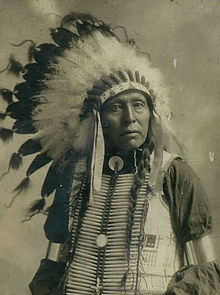Flying Hawk
Flying Hawk was an Oglala Lakota warrior, historian, educator and philosopher. Flying Hawks life chronicles the history of the Oglala Lakota people through the 19th and early 20th centuries, as he fought to deflect the worst effects of white rule educate his people and preserve sacred Oglala Lakota land and heritage. Chief Flying Hawk was a combatant in Red Clouds War and in nearly all of the fights with the U.S. Army during the Great Sioux War of 1876. He fought alongside his first cousin Crazy Horse and his brothers Kicking Bear and Black Fox II in the Battle of the Little Big Horn in 1876, and was present at the death of Crazy Horse in 1877 and the Wounded Knee Massacre of 1890. Chief Flying Hawk was one of the five warrior cousins who sacrificed blood and flesh for Crazy Horse at the Last Sun Dance of 1877. Chief Flying Hawk is notable in American history for his commentaries and classic accounts of the Battle of the Little Big Horn, Crazy Horse and the Wounded Knee Massacre, and
Flying Hawk was born about full moon of March 1854, a few miles south of Rapid Creek, Lakota Territory. His father was Oglala Lakota Chief Black Fox, also known as Chief Black Fox I, Cut Forehead and Great Kicking Bear. Chief Black Fox had two wives who were sisters who bore him thirteen children. Iron Cedar Woman, the youngest sister, was Flying Hawks mother and had five children. The other wife had eight children. In a fight with the Crows, Chief Black Fox was shot below the right eye with an arrow. It was so deep that it could not be pulled out, but had to be pushed through the ear. Chief Black Fox died when he was eighty years old. When my father was dead a long time we went to see how he was on the scaffold where we put him. His bones were all that was left. The arrowpoint was sticking in the back of his skull. It was rusted. We took it home with us. Kicking Bear was Flying Hawks full and older brother. Kicking Bear was a noted warrior and leader of the Ghost Dance. Black Fox I
Source: Wikipedia

